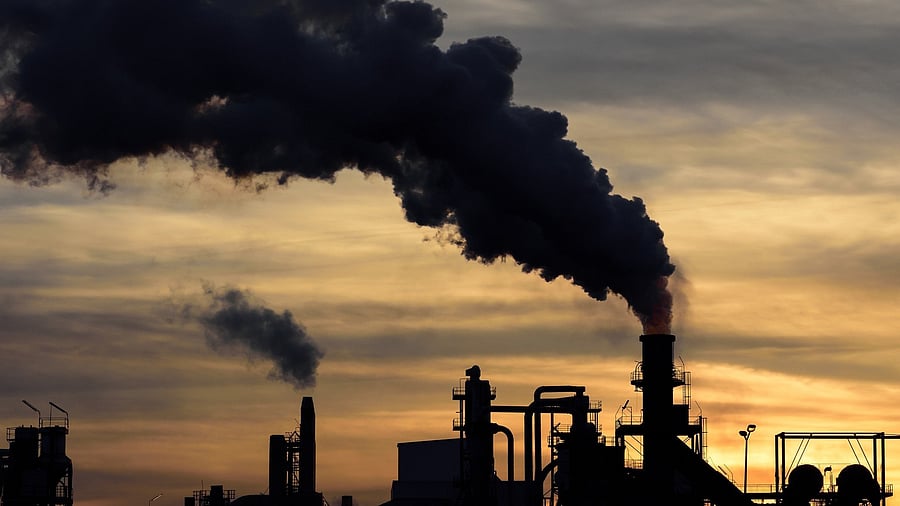
Representative image of carbon emissions from a factory.
Credit: iStock Photo
The European Union (EU)’s Carbon Border Adjustment Mechanism (CBAM), integral to the EU Green Deal, represents a strategic shift in global geopolitics of climate change, having significant implications for India. CBAM aims to create a level playing field for EU industries but has sparked debates about its fairness and the disproportionate burden it places on developing countries like India. By aligning the cost of embedded greenhouse gas emissions in imported goods, CBAM imposes additional financial burdens on exporters from developing nations. A key question that demands reflection is whether the recently adopted Article 6 of the Paris Agreement, finalised at COP 29 held in Baku, offers new opportunities for developing countries to mitigate trade risks from CBAM while facilitating developing countries in their effort to decarbonise their industries in a just and cost-effective manner.
CBAM sits within the broader “Fit for 55” legislative package by the EU, which aims at enhancing the EU Emission Trading System (EU-ETS) by holding both domestic producers and foreign exporters accountable for the carbon intensity of their goods. CBAM is proposed initially to be applied to carbon-intensive sectors such as cement, iron and steel, aluminium, fertilisers, electricity, and hydrogen and will fully phase in 2026 onwards. For developing countries, these regulations pose financial risks of additional costs on exports, potentially hindering their economic growth and industrial development. CBAM certificate prices, at present, are tied to the weekly average of EU ETS carbon prices, influenced by allowance availability, market demand, policy shifts, energy prices, and speculation.
Historically, the EU-ETS had served as the primary driver of the Clean Development Mechanism (CDM) market during its inception stages by integrating these CDM credits into its compliance framework, thereby incentivising participation in international emissions reduction projects. Similarly, for CBAM to support global decarbonisation, a complementary mechanism under Article 6 of the Paris Agreement could facilitate demand by linking CBAM to verified international carbon credits under the 6.2 and 6.4 framework.
By linking CBAM with Article 6 credits, a balanced system could emerge where importers in the EU offset their CBAM obligations through projects in developing countries. Articles 6.2 and 6.4, both under the UNFCCC framework (though differently structured), offer avenues to generate high-quality credits with corresponding adjustments that avoid double counting. These mechanisms can be leveraged by importers as well as the exporting industries through bilateral agreements under Article 6.2 or by purchasing Article 6.4 credits backed by the UNFCCC. The accounting for such credits under CBAM involves linking their cost to the effective carbon price through alignment with EU ETS benchmarks. Importers calculate their obligations based on the emissions embedded in imported goods, with credits serving to offset a portion of this obligation.
For example, if an EU importer purchases 10,000 tons of steel with embedded emissions of one ton of CO2 per ton, they must pay for 10,000 tons of CO2 emissions under CBAM. At an EU ETS price of €80 per ton, the cost would be €800,000. However, the importer could offset part of this obligation by purchasing Article 6 credits from projects like renewable energy in India, which reduces emissions by 5,000 tons, thereby halving the payment to €400,000 while channelling climate finance into decarbonisation efforts. A potential cap on credit prices could be introduced to stabilise market dynamics, providing predictability for both importers and exporters while preventing excessive volatility in compliance costs.
Implications for India
For India, the EU’s CBAM presents significant challenges, as highlighted by the World Bank’s Relative CBAM Exposure Index, which ranks India among the top five most exposed nations due to its high carbon emissions intensity and substantial export volumes to the EU. As per the study by CSE, at an estimated rate of €100 per tonne of CO2 equivalent, CBAM would impose a tax burden of roughly 25% on CBAM-covered goods, equivalent to 0.05% of India’s GDP in 2022-23. Indian exports, valued at around $8 billion annually in sectors like iron, steel, and aluminium, could face a carbon tax of 20% to 35%, undermining their competitiveness in the EU market.
Instead of framing CBAM as an isolated regulatory tool, leveraging Article 6 credits could further aid India in transitioning to a low-carbon pathway while keeping economic growth in perspective, providing a more equitable solution. However, this requires a coordinated effort to ensure that revenues from carbon pricing and credits directly support sustainable growth in the host country. Over time, a balanced integration of CBAM and Article 6 could create a more inclusive global carbon market, reducing disparities and fostering trust between developed and developing nations.
The interconnectedness of CBAM and Article 6, while promising, is not without challenges. One major issue is the verification of emission reductions. To link CBAM obligations with Article 6 credits, there must be an independent, rigorous process for verifying that emission reductions are real and additional. Establishing trust and ensuring capacity building in developing nations will be crucial for the success of this integration.
The intertwined future of CBAM and Article 6 credits highlights both the potential and the pitfalls of global climate policy. For developing countries like India, these mechanisms must be designed to address the inherent inequities in carbon budgets and provide practical pathways for sustainable growth. A modernised, cooperative framework—focused on equitable participation and mutual benefits—could transform CBAM from a challenge into an opportunity, ensuring that carbon costs are distributed fairly and that climate finance supports those who need it most.
(The writers are with the TERI School of Advanced Studies, New Delhi)